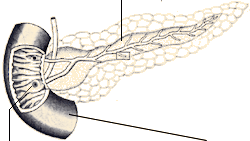Pancreatic Structure |
Pancreas |
 |
|
Diabetes is a disease that is becoming increasingly common and progressively complicated. There were approximately 175 million people afflicted with diabetes worldwide, according to a 1994 report released during the 15th International Diabetes Federation Congress. Clinicians used to treat it as a disease of high blood glucose; however, we now view it as a disease of many factors, involving abnormal breakdown of fat, protein and glucose. Glucose is the sugar our body uses as energy for our cells. Current management involves controlling glucose levels to minimize complications in the finer blood vessels (microvasculature) as well as controlling other metabolic abnormalities such as high blood pressure, high cholesterol / triglycerides, or obesity to prevent complications in the bigger blood vessels (macrovasculature).
Diabetes mellitus is a term that was coined by Aretaeus the Cappadocian, a first century Greek physician. According to the physician, "diabetes" means "to flow through like a siphon", and "mellitus" meant "honey". He also described diabetes as a disease that led to "sweet urine" and "siphoning or melting down of the flesh and limbs into urine".
The definition and management of diabetes mellitus have changed over the years. We used to differentiate the two different types of diabetes by its time of onset. A patient was diagnosed with juvenile-onset diabetes if he was discovered to have high blood glucose during childhood. The patient would be diagnosed with adult-onset diabetes if he was discovered to have uncontrolled glucose during adulthood, usually when they were elderly.
However, there were many patients who fell in between the age groups. In the last decade, there has been a dramatic increase of diabetes among people in their 20s and 30s; therefore, the terms "juvenile-onset" and "adult-onset" diabetes have become obsolete.
Patients were also categorized into having "insulin dependent diabetes mellitus (IDDM)" or "non-insulin dependent diabetes mellitus (NIDDM)". However, there are many patients now receiving both oral medications as well as insulins in order to control their diabetes.
Individuals with diabetes are currently categorized has being Type 1or Type 2.
 |
Type 1 diabetes results from an absolute lack of insulin. |
 |
Type 2 diabetes is due to a relative lack of insulin or insensitivity to the available insulin. |
There are also other intermediate stages of the disease:.
 |
Gestational diabetes occurs when a woman develops glucose intolerance only during pregnancy (this means her glucose levels rise higher due to physiological stress and the body is unable to secrete enough insulin to drive the glucose into the body's cells in order to utilize the glucose.) This is usually detected during or after the 2nd trimester and the woman carries a higher risk of developing diabetes later on in life. |
 |
Impaired glucose intolerance (IGT) or impaired fasting glucose (IFG), occurs when blood glucose is higher than normal, but not high enough to be classified as diabetes. Patients with IGT or IFG who continue to have uncontrolled glucose levels may eventually develop type 2 diabetes within 10 years. |
Many view diabetes as a progressive disease that initially surfaces as impaired glucose intolerance with a high post-meal glucose. (This means the glucose level is abnormally high after eating a meal.) The high glucose levels continue to demand the pancreas to secrete more insulin resulting in a state of hyperinsulinemia. However, the body becomes resistant to the insulin, and later develops a relative lack of insulin, and high fasting (before eating) glucose levels. Typically this pattern presents itself as type 2 diabetes. Eventual exhaustion of the islet cells (a type of cell in the pancreas that makes insulin) leads to a final stage of definite or absolute lack of insulin with a typical presentation of type 1 diabetes.
Metabolic Defects in Type 2 Diabetes
Within a population, type 2 diabetes is much more common than type 1 diabetes. For example, there are approximately 16 million people afflicted with diabetes in the United States, with approximately 90 to 95% of the patients having type 2 disease while only 5 to 10% has type 1 disease. Epidemiological studies have also found that type 2 disease is more common among African-Americans, Hispanic-Americans, Native Americans, Asian-Americans, and Pacific Islanders. These ethinic populations are more at risk of developing diabetes probably due to a genetic predisposition as well as the rapid adaptations to western cultures that include high fat diet and sedentary lifestyles. |